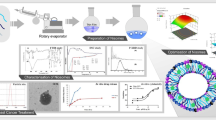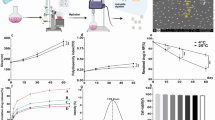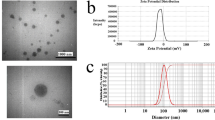Abstract
Recent clinical and epidemiological researches have declared that non-steroidal anti-inflammatory agents may display as antineoplastic agents and indicate pro-apoptotic and antiproliferative effects on cancer cells. The major purpose of this research was to develop a novel poly(ethyleneglycol)-block-poly(ε-caprolactone) (PEG-b-PCL) nano-sized particles encapsulated with nimesulide (NMS), a selective COX-2 inhibitor, and to evaluate its anticancer activity against MCF-7 breast cancer cells. NMS-encapsulated PEG-b-PCL nanoparticles were fabricated using three different production techniques: (i) by emulsion-solvent evaporation using a high shear homogenizer, (ii) by emulsion-solvent evaporation using an ultrasonicator, and (iii) by nanoprecipitation. Nanoparticles were evaluated with respect to the entrapment efficiency, size characteristics, drug release rates, thermal behavior, cell viability assays, and apoptosis. The resulting nanoparticles were found to be spherical shapes with negative surface charges. The average diameter of all nanoparticles ranged between 148.5 and 307.2 nm. In vitro release profiles showed that all nanoparticles exhibited a biphasic release pattern. NMS-loaded PEG-b-PCL nanoparticles demonstrated significant anticancer activity against MCF-7 breast cancer cells in a dose-dependent manner, and the effects of nanoparticles on cell proliferation were significantly affected by the preparation techniques. The nanoparticles developed in this work displayed higher potential for the NMS delivery against breast cancer treatment for the future.









Similar content being viewed by others
References
Ashok V, Dash C, Rohan TE, Sprafka MJ, Terry PD. Selective cyclooxygenase-2 (COX-2) inhibitors and breast cancer risk. Breast. 2011;20:66–70.
Chen B, Su B, Chen S. A COX-2 inhibitor nimesulide analog selectively induces apoptosis in Her2 overexpressing breast cancer cells via cytochrome c dependent mechanism. Biochem Pharmacol. 2009;77:1787–94.
Hascicek C, Sengel-Turk CT, Gumustas M, Ozkan SA, Bakar F, Das-Evcimen N, et al. Influence of polymer molecular weight on in-vitro characteristics and cytotoxicity of fulvestrant loaded nanoparticles. Curr Drug Ther. 2014;9:239–49.
Su B, Chen S. Lead optimization of COX-2 inhibitor nimesulide analogs to overcome aromatase inhibitor resistance in breast cancer cells. Bioorg Med Chem Lett. 2009;19:6733–5.
Kalalinia F, Mosaffa F, Behravan J. MCF-7 breast cancer cell line, a model for the study of the association between inflammation and ABCG2-mediated multi drug resistance. In: Gunduz M, Gunduz E, editors. Breast cancer—focusing tumor microenvironment, stem cells and metastasis. Rijeka: InTech; 2011. p. 343–58.
Diaz-Cruz ES, Shapiro CL, Brueggemeier RW. Cyclooxygenase inhibitors suppress aromatase expression and activity in breast cancer cells. J Clin Endoc Methabol. 2005;90:2563–70.
Su B, Diaz-Cruz ES, Landini S, Brueggemeier RW. Suppression of aromatase in human breast cancer cells by a cyclooxygenase-2 inhibitor and its analog involves multiple mechanism independent of cyclooxygenase-2 inhibition. Steroids. 2008;73:104–11.
Su B, Cai X, Hong Y, Chen S. COX-2 inhibitor nimesulide analogs are aromatase suppressors in breast cancer cells. J Steroid Biochem Mol Biol. 2010;122:232–8.
Zhong B, Cai X, Yi X, Zhou A, Chen S, Su B. In vitro and in vivo effects of a cyclooxygenase-2 inhibitor nimesulide analog JCC76 in aromatase inhibitors-insensetive breast cancer cells. J Steroid Biochem Mol Biol. 2011;126:10–8.
Liang M, Yang H, Fu J. Nimesulide inhibits IFN-γ-induced programmed death-1-ligand 1 surface expression in breast cancer cells by COX-2 and PGE2 independent mechanisms. Cancer Lett. 2009;276:47–52.
Sengel-Turk CT, Hascicek C, Dogan AL, Esendagli G, Guc D, Gonul N. Preparation and in vitro evaluation of meloxicam-loaded PLGA nanoparticles on HT-29 human colon adenocarcinoma cells. Drug Dev Ind Pharm. 2012;38:1107–16.
Sengel-Turk CT, Hascicek C, Dogan AL, Esendaglı G, Guc D, Gonul N. Surface modification and evaluation of PLGA nanoparticles: the effects on cellular uptake and cell proliferation on the HT-29 cell line. J Drug Del Sci Technol. 2014;24:166–72.
Turk CTS, Oz UC, Serim TM, Hascicek C. Formulation and optimization of nonionic surfactants emulsified nimesulide-loaded PLGA-based nanoparticles by design of experiment. AAPS PharmSciTech. 2014;15:161–76.
Wang L, Wamg S, Chen R, Wang Y, Li H, Wang Y, Chen M. Oridonin loaded solid lipid nanoparticles enhanced antitumor activity in MCF-7 cells. J Nanomat. 2014; Article ID903646.
Kuzma L, Wysokinska H, Rozalski M, Krajewska U, Kisiel W. An unusual taxodione derivative from hairy roots of Salvia austriaca. Fitoter. 2012;83:770–3.
Mosmann T. Rapid colorimetric assay for cellular growth and survival: application to proliferation and cytotoxicity assays. J Immunol Methods. 1983;65:55–63.
Rao JP, Geckeler KE. Polymer nanoparticles: preparation techniques and size-control parameters. Prog Polym Sci. 2011;36:887–913.
Vangeyte P, Gautier S, Jérôme R. About the methods of preparation of poly(ethylene oxide)-b-poly(ε-caprolactone) nanoparticles in water. Analysis by dynamic light scattering. Colloids Surf A. 2004;242:203–11.
Bernabeu E, Helguera G, Legaspi MJ, Gonzalez L, Hocht C, Taira C, et al. Paclitaxel-loaded PCL-TPGS nanoparticles: in vitro and in vivo performance compared with Abraxane. Colloids Surf B. 2014;113:43–50.
Reis CP, Neufeld RJ, Ribeiro AJ, Veiga F. Nanoencapsulation I. Methods for preparation of drug-loaded polymeric nanoparticles. Nanomedicine. 2006;2:8–21.
Budhian A, Siegel SJ, Winey KI. Haloperidol-loaded PLGA nanoparticles: systematic study of particle size and drug content. Int J Pharm. 2007;336:367–75.
Vivek R, Babu VN, Thangam R, Subramanian KS, Kannan S. pH-responsive drug delivery of chitosan nanoparticles as tamoxifen carriers for effective anti-tumor activity in breast cancer cells. Colloids Surf B. 2013;111:117–23.
Kondath S, Raghavan BS, Anantanarayanan R, Rajaram R. Synthesis and characterisation of morin reduced gold nanoparticles and its cytotoxicity in MCF-7 cells. Chem-Bio Interact. 2014;224:78–88.
Zhou S, Deng X, Yang H. Biodegradable poly(e-caprolactone)-poly(ethylene glycol) block copolymers: characterization and their use as drug carriers for a controlled delivery system. Biomaterials. 2003;24:3563–70.
Mu L, Feng SS. A novel controlled release formulation for the anticancer drug paclitaxel (Taxol®): PLGA nanoparticles containing vitamin E TPGS. J Control Release. 2003;86:33–48.
Meena R, Kesari KK, Rani M, Paulraj R. Effects of hydroxapatite nanoparticles on proliferation and apoptosis of human breast cancer cells (MCF-7). J Nanopart Res. 2012;14:712–23.
Vier J, Gerhard M, Wagner H, Hacker G. Enhancement of death-receptor induced caspase-8-activation in the death-inducing signalling complex by uncoupling of oxidative phosphorylation. Mol Immunol. 2004;40:661–70.
Author information
Authors and Affiliations
Corresponding author
Rights and permissions
About this article
Cite this article
Sengel-Turk, C.T., Hascicek, C., Bakar, F. et al. Comparative Evaluation of Nimesulide-Loaded Nanoparticles for Anticancer Activity Against Breast Cancer Cells. AAPS PharmSciTech 18, 393–403 (2017). https://doi.org/10.1208/s12249-016-0514-2
Received:
Accepted:
Published:
Issue Date:
DOI: https://doi.org/10.1208/s12249-016-0514-2




